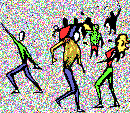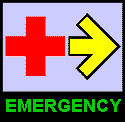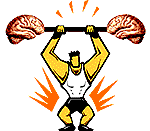Gamma hydroxybutyrate: An Overview Have you heard of GHB?
 You may not have yet, but its use is increasing. Once limited
to large warehouse scenes such as "raves," GHB is showing up at parties,
perhaps in neighborhoods like yours. It gives the user a feeling of
euphoria, that everything is fine. GHB, like alcohol, is a central nervous
system depressant that takes only minutes to make a user lose control,
forget what is happening, or lose consciousness. GHB is colorless,
odorless, and has a slightly salty taste. The synthetic form of GHB
contains some of the same ingredients as floor stripper and industrial
cleaners.
You may not have yet, but its use is increasing. Once limited
to large warehouse scenes such as "raves," GHB is showing up at parties,
perhaps in neighborhoods like yours. It gives the user a feeling of
euphoria, that everything is fine. GHB, like alcohol, is a central nervous
system depressant that takes only minutes to make a user lose control,
forget what is happening, or lose consciousness. GHB is colorless,
odorless, and has a slightly salty taste. The synthetic form of GHB
contains some of the same ingredients as floor stripper and industrial
cleaners.
 The same dose of GHB can have variable effects in different people. A
dose that makes one person feel euphoric can make another person sick. The
US Drug Enforcement Agency has linked GHB to 58 deaths since 1990 and
there have been at least 5,700 overdoses recorded since then. Moreover,
there are some reports that GHB can cause dependence. Treatment of GHB
overdoses is difficult because it is difficult for emergency room doctors
to detect the drug.
The same dose of GHB can have variable effects in different people. A
dose that makes one person feel euphoric can make another person sick. The
US Drug Enforcement Agency has linked GHB to 58 deaths since 1990 and
there have been at least 5,700 overdoses recorded since then. Moreover,
there are some reports that GHB can cause dependence. Treatment of GHB
overdoses is difficult because it is difficult for emergency room doctors
to detect the drug.
Possible symptoms of GHB use:
Dizziness | Vomiting | Seizures | Coma |
Drowsiness
 GHB was first developed as a general anesthetic, but because it did not
work very well to prevent pain, its use as an anesthetic declined. The
observation that GHB may cause the release of growth hormone led some
people, especially athletes and body-builders, to take it because they
thought it would increase muscle development. At the time, GHB was
available as a dietary supplement and as such was not regulated by the US
Food and Drug Administration. In 1990, after numerous reports that GHB
caused illness, the FDA began investigating the drug. It is now
classified as an illegal substance. Research is being conducted to
investigate the use of GHB in the treatment of the sleep disorder called
narcolepsy.
GHB was first developed as a general anesthetic, but because it did not
work very well to prevent pain, its use as an anesthetic declined. The
observation that GHB may cause the release of growth hormone led some
people, especially athletes and body-builders, to take it because they
thought it would increase muscle development. At the time, GHB was
available as a dietary supplement and as such was not regulated by the US
Food and Drug Administration. In 1990, after numerous reports that GHB
caused illness, the FDA began investigating the drug. It is now
classified as an illegal substance. Research is being conducted to
investigate the use of GHB in the treatment of the sleep disorder called
narcolepsy.
GHB has been grouped with other drugs in the "date-rape drug" category
such as Rohypnol, because it can be slipped
easily into a drink and given to an unsuspecting victim, who often does
not remember being assaulted. GHB is especially dangerous when
combined with alcohol.
GHB and the Brain

 Although GHB can be made in the laboratory, it is also produced normally
in the brain through the synthesis of a neurotransmitter called GABA.
Some of the greatest concentrations of GHB are found in the substantia
nigra, thalamus and hypothalamus. When GHB is ingested by a user, it
affects several different neurotransmitter
systems in the brain:
Although GHB can be made in the laboratory, it is also produced normally
in the brain through the synthesis of a neurotransmitter called GABA.
Some of the greatest concentrations of GHB are found in the substantia
nigra, thalamus and hypothalamus. When GHB is ingested by a user, it
affects several different neurotransmitter
systems in the brain:
- GHB can increase acetylcholine levels.
- GHB can increase serotonin levels.
- GHB can reduce dopamine activity, especially in the
basal ganglia. This action is probably the result of the inhibition of the
release of dopamine from synaptic terminals. Some studies show that GHB
first inhibits the release of dopamine, then causes the release of
dopamine. The effect on the dopamine system may depend on the dose of
GHB.
- GHB can activate GHB receptors and GABA receptors on neurons in the
brain.
Unfortunate Events Lead to a Tragedy
 One case of GHB use ended in tragedy. On January 16th, 1999, three girls
told their parents they were going to a movie, but instead they ended up
at a party at someone's house. Some kids were drinking alcohol and some
were smoking marijuana. One of the girls, ninth-grader Samantha, asked for
a Mountain Dew. A 19-year old boy got it for her. At one point, she told
her friend the soda tasted "gross," but she drank it. A few minutes later
she vomited and passed out. She was moved onto the bathroom floor, beside
another 14-year-old girl, Melanie, who also passed out after having a
drink. Once the boys became concerned that they could not wake the girls,
they took them to the hospital. Both girls fell into comas. Melanie
recovered, but Samantha never regained consciousness and died in the
hospital.
One case of GHB use ended in tragedy. On January 16th, 1999, three girls
told their parents they were going to a movie, but instead they ended up
at a party at someone's house. Some kids were drinking alcohol and some
were smoking marijuana. One of the girls, ninth-grader Samantha, asked for
a Mountain Dew. A 19-year old boy got it for her. At one point, she told
her friend the soda tasted "gross," but she drank it. A few minutes later
she vomited and passed out. She was moved onto the bathroom floor, beside
another 14-year-old girl, Melanie, who also passed out after having a
drink. Once the boys became concerned that they could not wake the girls,
they took them to the hospital. Both girls fell into comas. Melanie
recovered, but Samantha never regained consciousness and died in the
hospital.  In February 2000 the four males involved (ages 18, 19, and 26) went on
trial for the death of Samantha and the poisoning of the other girls, one
of whom ingested some GHB but had no symptoms. This was the first trial of
a GHB-related death. The younger males were found guilty of involuntary
manslaughter and lesser charges of poisoning. The 26-year-old was
convicted of being an accessory to manslaughter, poisoning, and possession
of marijuana and GHB. The jail time for the manslaughter convictions is up
to 15 years; the jail time for the poisoning convictions can be up to 5
years.
In February 2000 the four males involved (ages 18, 19, and 26) went on
trial for the death of Samantha and the poisoning of the other girls, one
of whom ingested some GHB but had no symptoms. This was the first trial of
a GHB-related death. The younger males were found guilty of involuntary
manslaughter and lesser charges of poisoning. The 26-year-old was
convicted of being an accessory to manslaughter, poisoning, and possession
of marijuana and GHB. The jail time for the manslaughter convictions is up
to 15 years; the jail time for the poisoning convictions can be up to 5
years.
 Law Enacted On February 18, 2000, President Clinton
signed federal legislation (H.R. 2130) making the possession of GHB
illegal. It was a controlled substance, a so-called Schedule 1 drug, just
like heroin. However, in July 2002, a form of GHB was designated as a
Schedule III Controlled Substance. A Schedule III substance can be used
for medical purposes, but it cannot be sold, distributed, or provided to
anyone other than for its prescribed use. The Controlled Substances
Act ranks drugs from 1 to 5 based on how harmful they are; a ranking
of 1 means that the drug has a high potential for abuse. The new
scheduling of GHB was made in response to new research showing that GHB
may help treat some symptoms of
narcolepsy.
|




 You may not have yet, but its use is increasing. Once limited
to large warehouse scenes such as "raves," GHB is showing up at parties,
perhaps in neighborhoods like yours. It gives the user a feeling of
euphoria, that everything is fine. GHB, like alcohol, is a central nervous
system depressant that takes only minutes to make a user lose control,
forget what is happening, or lose consciousness. GHB is colorless,
odorless, and has a slightly salty taste. The synthetic form of GHB
contains some of the same ingredients as floor stripper and industrial
cleaners.
You may not have yet, but its use is increasing. Once limited
to large warehouse scenes such as "raves," GHB is showing up at parties,
perhaps in neighborhoods like yours. It gives the user a feeling of
euphoria, that everything is fine. GHB, like alcohol, is a central nervous
system depressant that takes only minutes to make a user lose control,
forget what is happening, or lose consciousness. GHB is colorless,
odorless, and has a slightly salty taste. The synthetic form of GHB
contains some of the same ingredients as floor stripper and industrial
cleaners.
 Although GHB can be made in the laboratory, it is also produced normally
in the brain through the synthesis of a neurotransmitter called GABA.
Some of the greatest concentrations of GHB are found in the substantia
nigra, thalamus and hypothalamus. When GHB is ingested by a user, it
affects several different neurotransmitter
systems in the brain:
Although GHB can be made in the laboratory, it is also produced normally
in the brain through the synthesis of a neurotransmitter called GABA.
Some of the greatest concentrations of GHB are found in the substantia
nigra, thalamus and hypothalamus. When GHB is ingested by a user, it
affects several different neurotransmitter
systems in the brain:![[email]](./gif/menue.gif)
![[newsletter]](./gif/menunew.gif)
![[search]](./gif/menusea.gif)
